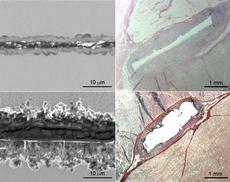Metallic glass for bone surgery
It is possible that broken bones will soon be fixed using metallic glass. Materials researchers at the ETH Zurich have developed an alloy that could lead to a new generation of biodegradable bone implants.

When bones break, surgeons need screws and metal plates to fix the broken bones in place. These supports are usually made of stainless steel or titanium. Once the bones have healed, the metal parts have to be removed from the body via further surgery. In order to reduce the burden on patients, materials researchers have taken up the task of producing implants from bioabsorbable metals. These implants should stabilize the bones only for as long as they need to heal. The metal dissolves in the body over time, rendering removal surgery unnecessary.
Implants made of magnesium-based alloys are proving particularly promising. These light metals are mechanically stable and ductile, and degrade quickly and completely by releasing ions which are tolerated by the body. However, all magnesium alloys have one major drawback: when they degrade in the body they produce hydrogen (H2). This in turn results in gas bubbles that hinder bone growth and thus the healing process, and may also lead to infections.
Success using metallic glass
ETH Zurich materials researchers from the laboratory of Jörg Löffler, Professor of Metal Physics and Technology, have now eliminated these side-effects by producing an innovative magnesium-zinc-calcium alloy in the form of a metallic glass which is biocompatible and shows fundamentally different degradation behaviour.
Metallic glasses are produced by rapid cooling of the molten material. The speed of the cooling process prevents the atoms from adopting the crystal structure found in traditional metals. As a result, metallic glasses have an amorphous structure like that of window glass. Thanks to this procedure, the researchers can add much more zinc to the molten magnesium than is possible with conventional alloys. The alloy developed by Löffler’s doctoral student Bruno Zberg contains up to 35% zinc and 5% calcium atoms, and the rest is made up of magnesium. A crystalline magnesium-zinc alloy can contain a maximum of 2.4% zinc atoms. If the percentage is higher, an undesired crystalline phase precipitates in the magnesium matrix.
Modified corrosion thanks to more zinc
The major advantage of a high percentage of zinc is that it fundamentally changes the corrosion of the magnesium: clinical tests with small amounts of the new magnesium-zinc-calcium alloy showed no hydrogen evolution!
This means that this new alloy, in the form of a metallic glass, has considerable potential as a non-harmful bone implant material. Convinced of this are not only Bruno Zberg, Peter Uggowitzer and Jörg Löffler, the project collaborators, but also the editors of Nature Materials, who published the scientific study in their online edition last Sunday.
Hot topic in materials science
Metallic glass is a hot topic in the field of materials science. Only since the early 1990s, says Jörg Löffler, could metallic glasses be produced in larger dimensions and be used as engineering material in the form of ‘bulk metallic glasses’. Since then laboratories have been searching intensively for applications for such glasses, which have several advantages over traditional metals. They are much more elastic than crystalline materials and demonstrate a strength that is two to three times higher. These properties would be valuable in bone implants, as metallic glass parts could carry out the same function as their traditional crystalline counterparts but be much smaller.
However, metallic glasses also have some disadvantages: their plasticity is not as high as that of normal metals; and, depending on the composition of the alloy, individual components can often only be produced in thicknesses of a few millimetres to centimetres (otherwise they cannot be cooled quickly enough, and a crystal structure forms). For this reason metallic glasses are mostly used in filigree devices, for example in the field of sensory applications and microtechnology.
The magnesium-zinc-calcium alloy developed by Bruno Zberg can be produced in a thickness of up to 5 millimetres. As Nature Materials writes, the deployment of metallic glass in bone implants would further increase the application area of this unusual material.
Reference
Zberg B, Uggowitzer PJ & Löffler JF. MgZnCa glasses without clinically observable hydrogen evolution for biodegradable implants. Nature Materials. Published online 27 September 2009, doi: 10.1038/nmat2542
- 26.02.10: Metallic glasses: Bone glue
- 14.10.09: Metallic Glasses: interesting
- 29.09.09: Metallisches Glas: Thin sections







READER COMMENTS